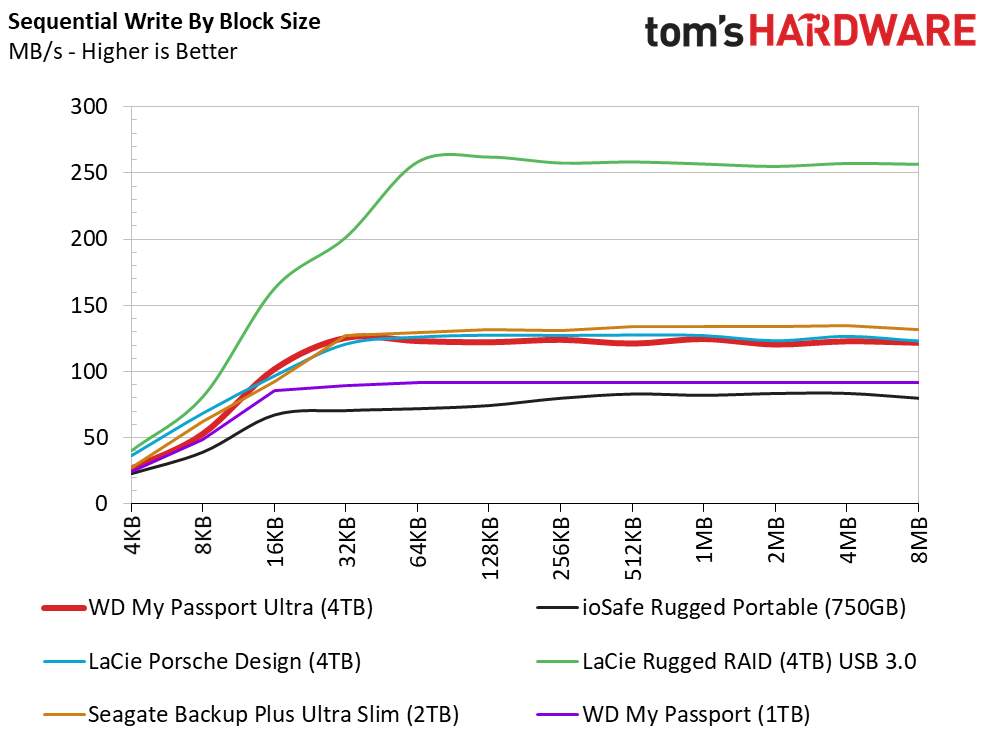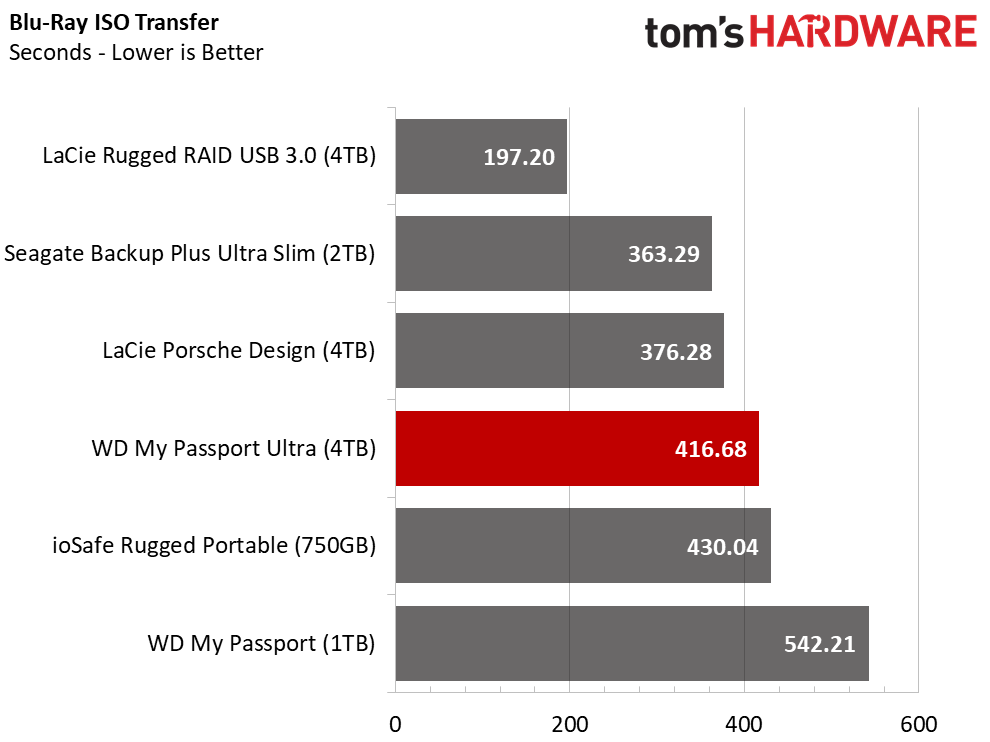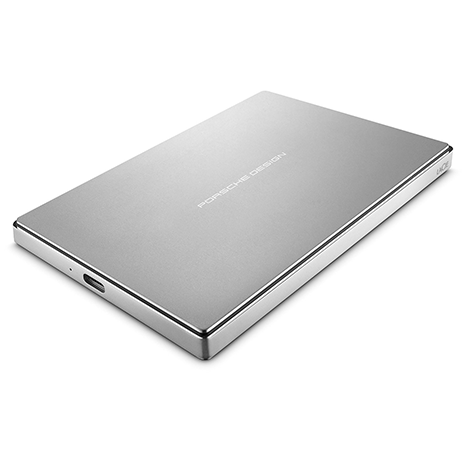WD My Passport Ultra HDD Review
Why you can trust Tom's Hardware
Performance Testing & Conclusion
Comparison Products
We tested the new Western Digital My Passport Ultra 4TB against a diverse group of portable HDD products including an older My Passport, which was one of the first USB 3.0 products to come to market.
We have two LaCie (now part of Seagate) 4TB products in this review. The Porsche Design Mobile Drive 4TB currently sells for $229.99 at Amazon. It's followed by the LaCie Rugged RAID Thunderbolt 4TB that currently sells for $379. The Rugged RAID uses a dual interface design that allows you to connect the drive to Thunderbolt 2 or USB 3.0 via a Micro-B connector. This drive uses two internal drives in RAID 0 but it is one of the most expensive products in the group.
The Seagate Backup Plus Ultra Slim only scales to 2TB, but it features a full-length metallic finish. The 2TB model currently sells for $129.99. That's very close to our My Passport Ultra 4TB we're testing, but it only comes with half the capacity.
The ioSafe Rugged Portable is the portable HDD you take into a war zone. The 1TB model from ioSafe.com costs nearly $1,200 thanks to its solid aluminum enclosure and IP68 rating. We have the first generation 750GB drive that is no longer in production. If you ask nicely and can pay the enormous cost, you can even get it in milled titanium.
Block Size Testing


The three modern drives (My Passport Ultra, LaCie Porsche Design, and Seagate Backup Plus Ultra Slim) deliver nearly identical performance as we increase the size of the data transfers. The newer drives provide a significant performance improvement over the two older products. The LaCie Rugged RAID uses a cost-increasing RAID 0 with two drives, but aside from that model, there isn't a clear performance leader.
It shouldn't come as a surprise that the newer products with higher platter densities and refined cache algorithms are faster than the older products. We often see people using older portable storage products. People often feel that the new models don't provide enough of a performance gain to justify a new purchase. In reality, newer products can deliver almost twice the performance of the drives sold just a few years ago.
Full LBA Span Performance


Like many newer HDDs, the Western Digital My Passport Ultra has an advanced cache system. WD originally developed the technology for enterprise use and migrated it downstream to consumer products. You can see the impact in our sequential read test across the entire usable LBA range.
Get Tom's Hardware's best news and in-depth reviews, straight to your inbox.
The write test shows how performance drops off as we move from the fastest to the slowest points of the platter. HDD vendors have learned to use the fastest area of the platter as a cache to back up the small DRAM buffer. The area is slower than DRAM, but it increases the overall performance. In some cases, drives keep frequently-accessed data in this reserved area for quicker access.
File Transfers



We don't run many application tests on external or portable storage products because the typical workload is sequential in nature. Even though it is possible, you shouldn't run an operating system on these drives. The typical use case is very basic. Most of us simply read and write large pieces of data for archiving or transferring data from one location to another.
We often see performance measured in throughput, but time-based results are easier to interpret because the sense of time is universal. We tested transfer performance with a Blu-ray ISO. For the Game test, we transferred data from a game directory to the portable drives. The Directory Test is a 15.2GB block of data that contains a mix of images, software installations, ISO files, and multimedia that yields a nice real-world workload.
The Western Digital My Passport Ultra 4TB trails the Seagate Backup Plus Ultra Slim 2TB and LaCie Porsche Design 4TB in the Blu-Ray ISO transfer test by 54 and 40 seconds, respectively.
The My Passport Ultra 4TB's advanced cache system helps it to outperform those two products when we add the smaller blocks in the game directory and backup directory tests. Typically, you can hear the drive working hard when you read or write small blocks of data to an HDD. Over the years the sound has been called many things, but "rock grinder" may be the best description. The My Passport Ultra, even during a 100% random write workload, doesn't make the sound or even vibrate much at all. This tells us the DRAM buffer and cache are collecting the incoming random data and then passing it to the platters as sequential data. That allows it to write at a much higher rate of speed.
The game directory test uses mostly small blocks, and the My Passport Ultra has a 10 second lead over its nearest competitor and a 20-second advantage over the LaCie Porsche Design 4TB. That's a 50% decrease in the amount of time it takes to write the data.
The backup directory test uses a mix of small, medium, and large files and is the equivalent of transferring your My Documents folder in Windows. The My Passport Ultra also performs extremely well in this test. This product is the fastest non-RAID palm-sized portable HDD available.
Conclusion
Some users will simply ignore the software features and others will embrace them. How much value you get from these "value add-ons" really depends on what type of user you are. For instance, a portable drive that you mainly keep in a travel or work bag won't do you much good as an automated backup destination for your home PC. On the other end of the usefulness scale, the password protected hardware 256-bit AES encryption is great if you travel with the drive. You can even add a "return-if-found" message that someone would see if they plug the drive into a system that doesn't have the encryption software installed.
Western Digital simply skipped over the write performance, which is clearly the unsung hero, on the specification sheet. The drive can write data very quickly and pulls away from competing products when you need to transfer small blocks of data. The My Passport Ultra is the fastest palm-sized, single drive, portable HDD we've tested with mixed workloads. You can spend a lot more and get faster performance, but you will have the typical RAID 0 overhead, decreased reliability, and increased expense and complexity. Most of us don't want to worry about those, or any other, issues when we are shopping for a simple device to tackle a simple task.
I still feel that the number one issue for these commodity products is simply pricing. Western Digital did a very good job positioning the My Passport Ultra, but the lower cost My Passport presents an interesting challenge. The Ultra 4TB model currently sells for $128.99 at Amazon, but we found the non-Ultra 4TB My Passport for $119. The Ultra ships with WD's Discovery software that you can download your social media and cloud storage data (Facebook, Instagram, Dropbox, and Google Drive), but the regular My Passport doesn't list this software on the official product page. It does show up on the My Passport downloads page, so it could just be an oversight.
Western Digital recently added another My Passport product to the family. The new version is tuned for Apple MAC users and features the same 1TB, 2TB, 3TB, and 4TB ($119) capacities as the rest of the family. The biggest change is that the Time Machine software and the other included packages work on the Apple operating system, but Western Digital also provides the MAC software to My Passport Ultra users via a quick download.
What we end up with are several options that all equal the same great experience. Western Digital provides the best balance of performance, software capabilities and pricing of any other product in this category with the My Passport series. You can pay a little more to get the two-tone color scheme or save a little by choosing the single color non-Ultra models.
MORE: Best SSDs
MORE: How We Test HDDs And SSDs
MORE: All SSD Content

Chris Ramseyer was a senior contributing editor for Tom's Hardware. He tested and reviewed consumer storage.
-
HERETIC-1 Hi Chris,Reply
Even as a commodity product,would be nice to know-How many platters in 4TB?
and power use? can it run off a USB2 port-2.5Watt?????????? -
lun471k Out of curiosity... did you open the drive ? Can we just rip it appart and plug it in as an internal drive ?Reply -
betam4x I purchased the Seagate 4TB backup plus for $109 from Sam's Club. Like most Purch sites these days, this seems like nothing more than a cash grab by Tom's hardware (via the Amazon Affiliate links in the article)...western digital arriving over a year late and their drive is priced similarly to 6 GB offerings from Seagate...Reply -
betam4x Somehow the words 'over a year ago' got left out. My first 4TB backup plus was purchased over a year ago for $109. I distrust both WD and Seagate since both have had issues in the past, but Seagate's backup plus has made me a believer. It is extremely small and does not require external power. WD's offering costs more than Seagate's 6TB offering...over a year later. I have 2 of the 4TB Seagate drives and I'm happy with them.Reply
Side note: I actually read tom's hardware from the mid 90s until they were acquired. Then I stopped reading. For good reason apparently. Purch is turning all their properties into nothing more than money making machines....god help them...I've got something in the works that is going to make them wish they had cared more about readers and less about profits...and this isn't my first rodeo in the biz...it's time they stopped pushing the all might dollar as the #1 and start focusing on the reason TH, AT, etc were so popular in the first place...



